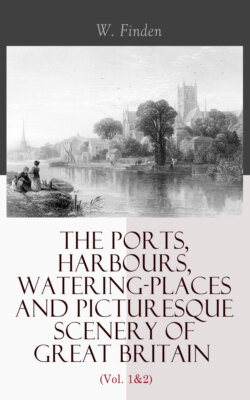Читать книгу The Ports, Harbours, Watering-places and Picturesque Scenery of Great Britain (Vol. 1&2) - W. Finden - Страница 31
На сайте Литреса книга снята с продажи.
CASTLE OF HOLY ISLAND, AND LINDISFARN ABBEY
ОглавлениеTable of Contents
In the present engraving the view is taken from the eastward on entering the harbour. To the right is the castle; beyond which, towards the centre of the view, are seen the ruins of the abbey. The setting sun sheds a warm, yet mellow light, over land and sea; and as evening is approaching, and the breeze freshening with the flood tide—for it is evident from the inward swell that the tide is flowing—the fishermen are seen making for the shore. The boats bound merrily before the wind, and
"——the waves, that murmur in their glee,
All hurrying in a joyful band,
Come dancing from the sea."
The painter when he made his sketch must have thoroughly felt the beauty of the scene, and been touched with the influence of the hour:—
"O Hesperus, thou bringest all good things!"
and inspirest poets to sing, and artists to paint the charms of eve's sweet hour in words and colours that never die—for once felt and communicated, they become impressed on the heart and soul of man, and live and bloom there for ever.
Holy Island, which is about two miles and a half long, and about two miles broad, lies off the Northumberland coast. On the south it is separated from the mainland by a deep channel about a mile broad. To the north-west it is connected with the mainland by a sand, which is dry at low water, and by which carts and passengers can pass to and from the island. Speed says that the Britons named it "Inis Medicante, for that, in manner of an island, it twice every day suffreth an extraordinarie inundation and overflowing of the ocean, which, returning unto her watery habitation, twice likewise makes it continent to the land, and laies the shoare bare againe, as before." It was called Lindisfarn by the Saxons; and in after times, from the celebrity of its monastery, and the holy men who had lived there, it acquired the name of Holy Island.
About 635, a church, of wood and thatched with reeds, was first built in Lindisfarn, by Aidan, a Scottish monk from the Isle of Iona, who exercised the office of bishop in Northumberland. It was afterwards built of stone, and gave title to a bishop, until the see was removed to Durham in 995. The monastery continued as a cell, dependent on Durham, till it was suppressed by Henry VIII. A considerable part of the old church, with circular arches in what is termed the Saxon style, is yet standing, and forms, with the adjacent ruins, a most picturesque object. The village, or as it is usually called "the town," lies at a short distance to the northward of the ruins of the monastery, and is chiefly inhabited by fishermen, about two-thirds of whom are also licensed by the Trinity-house at Newcastle to act as pilots for their own harbour and the adjacent coast.
The fishery for cod, ling, and haddock is usually carried on in cobles. These boats are very generally employed in the coast fishery from the Tweed to the Humber. They are sharp and wedge-shaped at the bow, but flat-bottomed towards the stern. They have only one mast, stepped close forward, on which a lug sail is set. They are excellent sea boats, and, for their size, carry a large sail. The usual length of a Holy Island coble is from twenty-five to twenty-seven feet, of which there are about sixty belonging to the island. A great quantity of the fish thus caught is sent to London in smacks, employed by fishmongers or salesmen there, who annually contract with the fishermen to pay them so much per score for all the fish sent during the season. From December to April many lobsters are caught off Holy Island, nearly the whole of which are sent to London.
For the herring-fishery, boats of a larger size are employed. They are from thirty to thirty-six feet long, about eleven feet broad, and from four and a half to five feet deep. They carry two lug sails, and have no deck. The herring-fishery commences off Holy Island about the 20th of July, and usually terminates early in September. Many herrings are caught in the Fare-way, between the Farn islands and the main-land; but the principal fishery for them is generally a little to the southward of the Staples, a cluster of small islands which lie from two to three miles to the eastward of the Farns. Most of the herrings caught by the Holy Island fishermen are taken to Berwick to be cured, and are thence chiefly exported to London, Hull, and Newcastle.
On the beach to the westward of the island, the fossils called St. Cuthbert's beads—the entrochi of naturalists—are found. They are also to be observed in the cliff to the north-east. A rock which lies at a short distance from the south-west point of the island is called St. Cuthbert's rock, where in former times superstition feigned that the saint was wont to sit and
"——frame
The sea-born beads that bear his name."
This article of popular credulity has, however, been long exploded, and the fisherman when he hears the stones rattle on the beach from the force of the waves, no longer imagines that the sound proceeds from the saint's hammer.
CASTLE ON HOLY ISLAND. FROM THE WEST.
